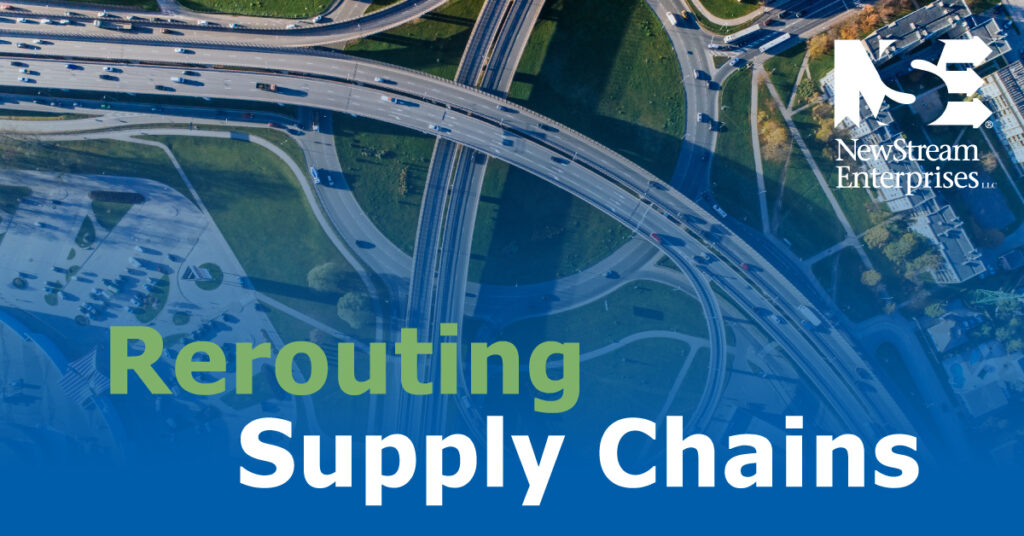With the advancement of digital technologies that enable real-time management of supply chains, coordinating global supply lines across a wide range of industries—from food and beverage to pharmaceuticals and healthcare—is now possible. This is especially helpful because, as we’ve learned with COVID-19, supply chain ecosystems can be impacted by catastrophic events such as trade issues, natural disasters, pandemics and others. To maintain supply chain effectiveness and serve customer needs, procurement and compliance strategies must include better planning, decision-making and execution.
In the case of unavoidable events, supply chain management plans should address both short-term and long-term contingencies that enable companies to more readily reroute supply chains when needed. The specialization and focus of a supply chain service provider enables companies to create a more flexible supply chain that is adaptable to changes in the delivery process as well as supply and demand.
The Need for Proactive Supply Chain Strategies
Since the coronavirus outbreak has affected China’s supply chain, some multinational companies have moved production out of that country and are looking for alternative sources of spare parts or relocating operations to other parts of the world. Many are coming to the U.S. because there are currently no other sites to replace China as a source of large-scale manufacturing. Or, they are looking in China for companies from which to deliver by diversifying the supplier base while minimizing the number of suppliers in their supply chains and the production capacity available.
Experts see no sign that companies are choosing not to return to China entirely. But it does appear that they are exploring new source countries that offer higher wages and better conditions than China, even if the move would only be a stopgap measure until the Chinese supplier is back online again.
In the geo-economic sphere, many companies are hurrying to scale back production in order to avoid a repeat of the damage caused by the pandemic and the collapse of entire global supply chains because they rely on a single source for products, parts or materials. This upheaval threatens to change the way the world does business, and has attracted many nations that want to benefit from the fact that companies are shifting production away from China.
Sourcing Shift Strategies
The increasing use of supply chain shift strategies can reduce the volatility of inventories and supply volumes by delaying certain processes and completing them at a later point. Managing the interconnected risks of shifting and redirecting supply chains, establishing new partners and creating new processes is no easy task and requires a holistic approach to logistics and supply chain management.
Rerouting Strategies
Changing the route of a particular section of the supply chain can reduce transport and warehousing costs while decreasing time-to-market. It also creates opportunities to increase local procurement. As a result, indirect costs such as warehousing and obsolescence are indirectly linked to production costs. In response, some U.S. companies have been able to reduce these costs to some extent by reassessing and revising their supply chains
For example, a multinational software company could deliver orders directly from its manufacturing facilities in Hong Kong rather than from its manufacturing facility in the U.S. This results in shipments that are managed and executed more efficiently.
Once products have been shipped, increased flexibility now available in delivery processes allows customers to redirect shipments to the most convenient destination. Customers benefit from flexible storage capacities and can access additional storage if needed, such as in the event of a supply chain interruption or emergency.
Future Supply Chain Realities
In many industries, the intermediates components that are normally transported by passenger aircraft can be hard to obtain during a supply chain disruption, leading to supply bottlenecks that require companies to find other markets. Truck capacity in China is also declining, leading to a transportation bottleneck, even when supplies make it to ports. All these factors have led to higher costs and production challenges, as timelines are delayed.
Recent history has taught us that companies need to begin building supply capacity outside China. The key is to relocate procurement and production activities by negotiating contracts with suppliers that offer capacity in several countries before geopolitical risks and other factors again threaten to curb supply. At the same time, management teams should be examining the existing supply chain network to re-balance production and reap the benefits of free trade zones.
At NewStream Enterprises, LLC, our supply chain management services are focused on our partners’ needs and based on forward-thinking plans of action. Our experienced and strategically minded team quickly helps partners expand their inventory and adjust fulfillment strategies to address uncertainty and trade tensions. This procurement flexibility is essential in enabling our customers to reduce risks in their global supply chains.
Our employee-owned warehouses can hold inventories to mitigate the risk of supply chain disruptions, limit the impact of global economic and political events, and accelerate the response to changing retail demand.

